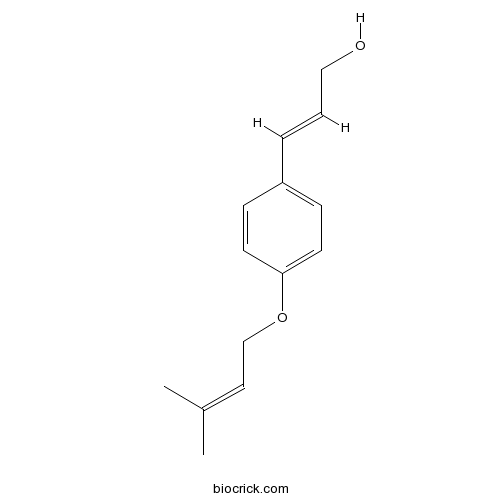Evofolin CCAS# 163634-05-7 |

Quality Control & MSDS
3D structure
Package In Stock
Number of papers citing our products

| Cas No. | 163634-05-7 | SDF | Download SDF |
| PubChem ID | 44445795 | Appearance | Powder |
| Formula | C14H18O2 | M.Wt | 218.29 |
| Type of Compound | Phenylpropanoids | Storage | Desiccate at -20°C |
| Solubility | Soluble in Chloroform,Dichloromethane,Ethyl Acetate,DMSO,Acetone,etc. | ||
| Chemical Name | (E)-3-[4-(3-methylbut-2-enoxy)phenyl]prop-2-en-1-ol | ||
| SMILES | CC(=CCOC1=CC=C(C=C1)C=CCO)C | ||
| Standard InChIKey | ROCWIPIJKMWFFA-ONEGZZNKSA-N | ||
| Standard InChI | InChI=1S/C14H18O2/c1-12(2)9-11-16-14-7-5-13(6-8-14)4-3-10-15/h3-9,15H,10-11H2,1-2H3/b4-3+ | ||
| General tips | For obtaining a higher solubility , please warm the tube at 37 ℃ and shake it in the ultrasonic bath for a while.Stock solution can be stored below -20℃ for several months. We recommend that you prepare and use the solution on the same day. However, if the test schedule requires, the stock solutions can be prepared in advance, and the stock solution must be sealed and stored below -20℃. In general, the stock solution can be kept for several months. Before use, we recommend that you leave the vial at room temperature for at least an hour before opening it. |
||
| About Packaging | 1. The packaging of the product may be reversed during transportation, cause the high purity compounds to adhere to the neck or cap of the vial.Take the vail out of its packaging and shake gently until the compounds fall to the bottom of the vial. 2. For liquid products, please centrifuge at 500xg to gather the liquid to the bottom of the vial. 3. Try to avoid loss or contamination during the experiment. |
||
| Shipping Condition | Packaging according to customer requirements(5mg, 10mg, 20mg and more). Ship via FedEx, DHL, UPS, EMS or other couriers with RT, or blue ice upon request. | ||
| Description | 1. Evofolin C and its acetate show strong antifungal and antibacterial activity. 2. Evofolin C exhibits potent inhibition against N-formylmethionylleucylphenylalanine-induced superoxide production with IC(50) values less than 12 microM. |
| Targets | Immunology & Inflammation related | Antifection |

Evofolin C Dilution Calculator

Evofolin C Molarity Calculator
| 1 mg | 5 mg | 10 mg | 20 mg | 25 mg | |
| 1 mM | 4.5811 mL | 22.9053 mL | 45.8106 mL | 91.6212 mL | 114.5265 mL |
| 5 mM | 0.9162 mL | 4.5811 mL | 9.1621 mL | 18.3242 mL | 22.9053 mL |
| 10 mM | 0.4581 mL | 2.2905 mL | 4.5811 mL | 9.1621 mL | 11.4527 mL |
| 50 mM | 0.0916 mL | 0.4581 mL | 0.9162 mL | 1.8324 mL | 2.2905 mL |
| 100 mM | 0.0458 mL | 0.2291 mL | 0.4581 mL | 0.9162 mL | 1.1453 mL |
| * Note: If you are in the process of experiment, it's necessary to make the dilution ratios of the samples. The dilution data above is only for reference. Normally, it's can get a better solubility within lower of Concentrations. | |||||

Calcutta University

University of Minnesota

University of Maryland School of Medicine

University of Illinois at Chicago

The Ohio State University

University of Zurich

Harvard University

Colorado State University

Auburn University

Yale University

Worcester Polytechnic Institute

Washington State University

Stanford University

University of Leipzig

Universidade da Beira Interior

The Institute of Cancer Research

Heidelberg University

University of Amsterdam

University of Auckland

TsingHua University

The University of Michigan

Miami University

DRURY University

Jilin University

Fudan University

Wuhan University

Sun Yat-sen University

Universite de Paris

Deemed University

Auckland University

The University of Tokyo

Korea University
- Fmoc-D-Trp(Boc)-OH
Catalog No.:BCC3561
CAS No.:163619-04-3
- Kadsulignan N
Catalog No.:BCN3631
CAS No.:163564-58-7
- Vilazodone
Catalog No.:BCC2040
CAS No.:163521-12-8
- Vilazodone Hydrochloride
Catalog No.:BCC2041
CAS No.:163521-08-2
- Triptoquinonide
Catalog No.:BCN1724
CAS No.:163513-81-3
- Flufenamic acid
Catalog No.:BCC9162
CAS No.:530-78-9
- Fmoc-Met(O2)-OH
Catalog No.:BCC3531
CAS No.:163437-14-7
- 2',4'-Di-O-(E-p-coumaroyl)afzelin
Catalog No.:BCN6512
CAS No.:163434-73-9
- Stachybotrylactam
Catalog No.:BCN6967
CAS No.:163391-76-2
- FIIN-2
Catalog No.:BCC3974
CAS No.:1633044-56-0
- Bethoxazin
Catalog No.:BCC5471
CAS No.:163269-30-5
- Sitafloxacin Hydrate
Catalog No.:BCC4959
CAS No.:163253-35-8
- Kadsulignan L
Catalog No.:BCN3627
CAS No.:163660-06-8
- Pazufloxacin mesilate
Catalog No.:BCC9114
CAS No.:163680-77-1
- WIN 64338 hydrochloride
Catalog No.:BCC6914
CAS No.:163727-74-0
- Auristatin F
Catalog No.:BCC5522
CAS No.:163768-50-1
- YM 90709
Catalog No.:BCC7149
CAS No.:163769-88-8
- 7beta-Hydroxyrutaecarpine
Catalog No.:BCN6500
CAS No.:163815-35-8
- Salvianolic acid Y
Catalog No.:BCN8123
CAS No.:1638738-76-7
- Androstenediol-3-acetate
Catalog No.:BCC8829
CAS No.:1639-43-6
- 8(17),12E,14-Labdatrien-20-oic acid
Catalog No.:BCN7396
CAS No.:1639257-36-5
- 12E,14-Labdadien-20,8beta-olide
Catalog No.:BCN7395
CAS No.:1639257-37-6
- Kaempferol-3-O-(6''-O-cis-coumaryl)glucoside
Catalog No.:BCN1538
CAS No.:163956-16-9
- Longiferone B
Catalog No.:BCN7378
CAS No.:1639810-67-5
New phenylpropenoids, bis(1-phenylethyl)phenols, bisquinolinone alkaloid, and anti-inflammatory constituents from Zanthoxylum integrifoliolum.[Pubmed:17822293]
J Nat Prod. 2007 Sep;70(9):1444-8.
Five new compounds, including two new phenylpropenoids, (R,E)-1-[4-(3-hydroxyprop-1-enyl)phenoxy]-3-methylbutane-2,3-diol (1) and 4-hydroxy-3-(3-methyl-2-butenyl)cinnamyl alcohol (2), two new bis(1-phenylethyl)phenols, 2,6-bis(1-phenylethyl)phenol (3) and 2,4-bis(1-phenylethyl)phenol (4), and a new bisquinolinone alkaloid, 18-demethylparaensidimerin C (5), together with 17 known compounds have been isolated from the stem wood of Zanthoxylum integrifoliolum. The structures of these new compounds were determined through spectral analyses including extensive 2D nuclear magnetic resonance data. Among the isolates, N-methylflindersine (7), (-)-simulanol (10), and evofolin-C (16) exhibited potent inhibition against N-formylmethionylleucylphenylalanine-induced superoxide production with IC(50) values less than 12 microM.
Prenylated phenylpropenes from Coleonema pulchellum with antimicrobial activity.[Pubmed:9272968]
Phytochemistry. 1997 Jul;45(6):1207-12.
The lipophilic root extract of Coleonema pulchellum was analysed and tested for antifungal and antibacterial activity. Eight previously undescribed prenyloxy and geranyloxy phenylpropenes, were isolated as major compounds together with the known evofolin-C as well as the lignans (+/-)-sesamin and (+/-)-prenylpiperitol, the diterpene (-)-pimara-9(11),15-dien-19-oic acid and the 2,4-decadienoic acid isobutylamide. All structures were established by spectroscopic evidence. From the new phenylpropenes, named evofolin-C-acetate, colenemol, colenemal, prenycol acetate, dehydroprenycol acetate, precolpuchol, colpuchol and colpuchol acetate, the dihydroxylated precolpuchol displayed the strongest antifungal and antibacterial activity against Cladosporium herbarum and Staphylococcus aureus, respectively.


